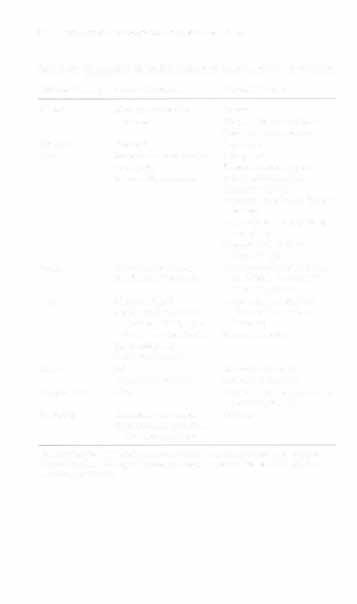i bc27f85be50b71b1 (117 page)
Read i bc27f85be50b71b1 Online
Authors: Unknown

size, shape, and Hgb distribution. WBCs are examined for proportion
and the presence of immature cells. Finally, Pits are examined for
number and shape." Peripheral blood smear results are correlated
with the other laboratory tests to diagnose hematologic disease.
Coagulation Profile
Coagulation tests assess the blood's ability to clot. The tests used to
determine c10rting are prothrombin time (PT) and partial thromboplastin time (PTT). An adjunct to the measurement of PT is the International Normalized Ratio (INR). The INR was created to ensure reliable and consistent measurement of coagulation levels among all



Table 6-8. Erythrocyte Indices: V:t1ues and inrerpretation·
Test
Description
Value
Interpretation
Mean corpuscular volume
Mean size of a single
80-100 pgJ
Increased by macrocytic, folic acid, or vitamin
(MCV) (Het x 101RBC)
RBC in a pi of
BI2 deficiency anemias; liver disease; and
blood
recent alcohol use.
Decreased by microcytic, iron-deficiency, and
hypochromic anemias; thalassemia; and lead
pOisoning.
Mean corpuscular hemoglobin
Amount of Hgb in one
26-34 pglcell
Increased by macrocytic anemia.
(MCH) (Hgb x 101RBC)
RBC
Decreased by microcytic anemia.
Low mean corpuscular hemoglobin indicates
<
Hgb deficiency.
�
Mean corpuscular hemoglobin
Proportion of eaeh
3 1-37 gldl
Increased by spherocytosis (small round
n
c
concentration (MCHC)
RBC occupied by
RBC).
!;:
'"
(HgblHet x 100)
Hgb
Decreased by microcytic, hypochromic, and
�
iron-deficiency anemias and thalassemia.
�
�
Het = hematocrit; Hgb = hemoglobin; RBC = red blood cell.
>
Z
"'Lab values vary among laboratories.
o
Sources: Adapted from RJ Elin. LaboratOry Reference Intervals and Values. In L Goldman, JC Bennett (cds). Cecil Textbook of Medicine,
�
Vol. 2 (21 st cd). Philadelphia: Saunders, 2000;2305j and E Matassarin-Jacobs. Assessment of Clients with Hemarologic Disorders. In JM
Black. E Marassarin·Jacobs (eds), Medical-Surgical Nursing Clinical Management for Continuity of Care (5th cd). Philadelphia: Saun
�
ders, 1997;1466.
5
Q
w
00
w


384 ACUTE CARE HANDBOOK FOR PHYSICAL THERAI'ISTS
laboratories. The INR is the ratio of the patient's PT to the standard
PT of the laboratory, raised by an exponent (the sensitivity index of
the reagent) provided by the manufacturer.'2 Table 6·9 summarizes
PT/INR and PTT.
Clinical Tip
When confirming an order for physical therapy in the phy·
sician's orders, the therapist must be sure to differentiate
between the order for physical therapy and the blood tesr
(i.e., rhe abbreviarions for both physical therapy and prothrombin time are PT).
Pathophysiology
This section is divided into a discussion of vascular and hematologic
disorders.
Vasclilar Disorders
Vascular disorders are classified as arterial, venous, or combined arterial and venous disorders. Clinical findings differ berween anerial and venous disorders, as described in Table 6-10.
Arterial Disorders
Atherosclerosis
Atherosclerosis is a diffuse and slowly progressive process characterized by areas of hemorrhage and the cellular proliferation of mono·
cytes, smooth muscle, connective tissue, and lipids." The development
of atherosclerosis begins early in life with risk factors that include the
followingM.Il-IS:
.. Arteriosclerosis is a general term used to describe any wall thickening or
hardening in the arteries. The term atheroma is applied to plaque formation
with farty material in the vessel wall.


Table 6-9. Coagulation Profile
Test
Description
Value" (sees)
J ndicationlInterpreta tion
PrOthrombin rime!
Examines the extrinsic
PT 11-15
Used to assess the adequacy of warfarin
international
and common dor
(Coumadin) therapy or ro screen for
normalized ratio
ring facmrs I, II, V,
bleeding disorders
(PT/INR)
VII, and X
Increased: Coumarin therapy, liver diseases,
bile duct obstruction, diarrhea, salicylate
intoxication, Ole, hereditary facro[ deficiency, alcohol use, or drug interaction
Decreased: Diet high in fat or leafy vegetables, or drug interaction
Partial thromboplastin
Examines the intrinsic
PIT 60-70
Used to assess the adequacy of heparin therrime (PIT) (acriand common clot
�
APIT 30--40
apy and ro screen for bleeding disorders
vared PIT [APIT] is
ting factors I, II, V,
Increased: Heparin or coumarin therapy,
i:
"
a rapid version of
VIII, IX, X, XI
liver disease, vitamin K or congenital dot
�
-<
PIT)
ting factor deficiency, DrC
Decreased: Extensive cancer, early DIC
�
>
ole
8
= disseminated imr:lVascular coagulopathy.
·Values for prothrombin rime (PT) and PlT vary between laborarories.
:t
m
Source: Dara from KD Pagana, TJ Pagana. Blood Srudies. Mosby's Manual of Diagnostic and Laborarory Tests. St. Louis: Mosby, 1998.
"
�
§
-<
w
00
'"

